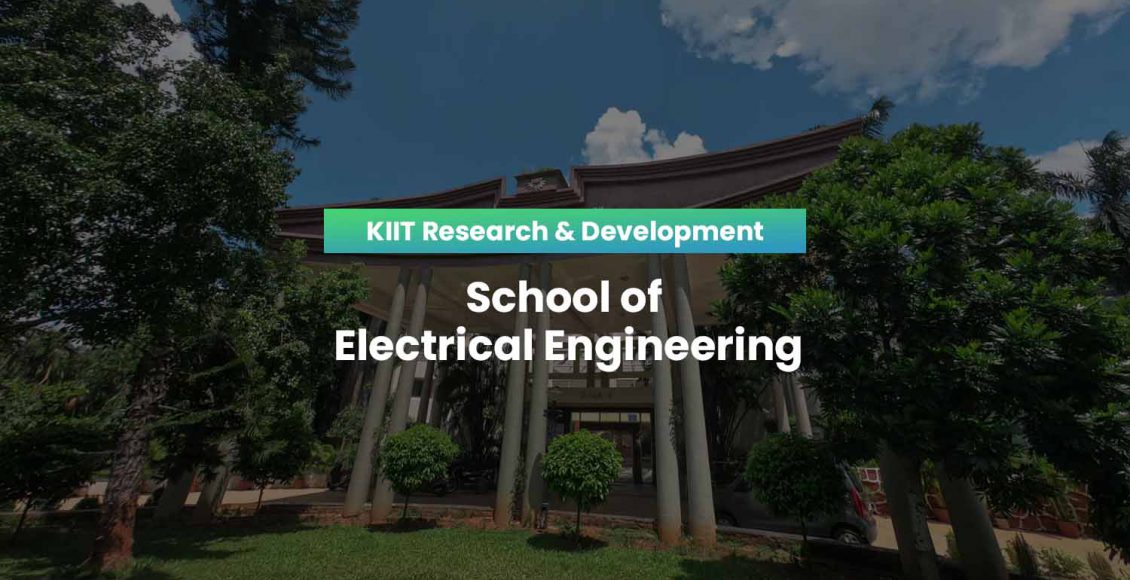School of Electrical Engineering (November 2021)
National/International Awards
Education Expo TV’s Research Wing for Excellence in Professional Education & Industry, Mumbai
Dr. Arjyadhara Pradhan
Title of the Award: Best Faculty Award
Award Received: 9th Academic Achievement Awards-2021,

Dr ArjyadharaPradhan, Faculty School of Electrical Engineering, Kalinga Institute of Industrial Technology deemed to be University has been awarded “BEST FACULTY AWARD” by TV’s Research Wing for Excellence in Professional Education & Industry, Mumbai, 2021. She has published 9 patents, both national and international, and has received grant for 7 patents in the year 2020–2021. She has completed projects from The Institute of Engineers India and has published many papers in reputed journals and conferences and as book chapters. She has also received many other awards from different reputed organisations.
Journal Papers
1. Kumari, K. S., Samal, S., Mishra, R., Madiraju, G., Mahabob, M. N. and Shivappa, A. B. (2021), Diagnosing COVID-19 from CT Image of Lung Segmentation & Classification with Deep Learning Based on Convolutional Neural Networks, Wireless Personal Communications, pp. 1–17. https://doi.org/10.1007/s11277-021-09076-w (IF 1.671).
Abstract
Early-stage exposure and analysis of diseases are life-threatening causes for controlling the spread of COVID-19. This paper aims to establish image classifiers to determine whether a patient is tested positive or negative for COVID-19 cantered on lung CT scan imageries. In doing so, a Visual Geometry Group-16 (VGG-16) and a Convolutional Neural Network (CNN) 3-layer model is used for marking. The images are first segmented using K-means Clustering before the classification to increase classification efficiency. Then, the VGG-16 model and the 3-layer CNN model were implemented on the raw and segmented data. The impact of the segmentation of the image and two versions are explored and compared, respectively.
2. Roy, T., Aarzoo, N. and Dasgupta, A (2021), Development of generalised and optimum structures of a multilevel inverter using switched capacitor technique for renewable energy conversion systems, International Journal of Power Electronics, Vol. 14, No. 1, pp. 91 – 118,
DOI: 10.1504/IJPELEC.2021.116649.
Abstract
The article presents a novel switched capacitor multilevel inverter topology. The prime features of the proposed inverter are the following: (a) It uses symmetrical DC power sources to generate different output voltage levels, (b) It has self-voltage balancing capability to balance the capacitor voltages, and (c) It can boost the input voltages to desired voltage levels at the load end. Extensive simulation and experimental studies of a 17-level inverter prove the merits and effectiveness of the proposed inverter. The inverter is applicable in renewable energy conversion systems such as photovoltaic (PV) systems to generate boosted multilevel output voltage from low voltage PV sources.
3. Ray, M., Samal, P. and Panigrahi, C. K. (2021), The influencing Factors on Efficacy Enhancement of HVAC Systems–A Review, Materials Today: Proceedings, pp. 1–8, https://doi.org/10.1016/j.matpr.2021.07.264.
Abstract
The accurate estimation of heating load (HL) and cooling load (CL) of HVAC system in a building is very important. It has been studied that the building design parameters optimization approach alone can provide up to 62.1% electrical energy consumption reduction compared to buildings that are not designed for efficient energy usage. Recent research has demonstrated that a combination of existing HVAC technologies can offer effective solutions for energy conservation and thermal comfort. In this study various energy saving strategies for HVAC systems are investigated and different measures on further energy and cost savings in buildings are discussed.
4. Pati, N. and Panda, B. (2021), Control and Regulation of the Conversion Phase of a Double-Stage Grid Connected PV System: H∞ and Voltage Sliding Mode Control, Journal of Electrical Engineering and Technology, Vol. 16, No. 5, pp. 2731–2742, https://doi.org/10.1007/s42835-021-00761-1(IF: 1.069).
Abstract
This paper had attempted to validate and compare the performance of two different non-linear robust controllers that can be applied for a double stage grid connected system. In double stage grid connected systems, the output of variable Photovoltaic source is fed to a dc-dc converter and then to an inverter which is further connected to the grid. The purpose of the controllers in the conversion phase is to control the switching of the dc-dc converter to provide a regulated dc output voltage in varying atmospheric or load conditions. The designs of the controllers are done using the dynamics of the converter itself and their robustness are verified using various results performed under Simulink Environment.
Conference Paper
1. Samal, P., Mohanty, S., Patel, R., Behera, S., and Mishra, S. (2021), Optimal Allocation of Distributed Generation in Distribution system by Using Black Widow Optimization Algorithm, In 2nd International Conference for Emerging Technology (INCET), Belagavi, India, pp. 1–5, 10.1109/INCET51464.2021.9456117.
Abstract
This paper proposes the Black widow optimization algorithm, a nature-inspired technique for the optimal allocation of a distributed generation (DG) in a 69-bus distribution system. The main aim of this paper is to reduce overall real power loss in distribution systems. The effect of DG placement on total device reactive power loss, individual branch loadings, and voltage magnitude at each distribution bus is also investigated. The steady state power flow solutions are determined using load flow technique. In comparison to some of the other approaches listed in the study, the proposed BWOA achieves lower total active power loss.
Book Chapters
1. Gautam, R. K., Behera, S., and Patel, R. (2021), Effect of Irradiance on THD of Neutral Point Clamped Inverter Fed from PV Cell, In DC—DC Converters for Future Renewable Energy Systems. Energy Systems in Electrical Engineering, Priyadarshi, N., Bhoi, A. K., Bansal, R.C., and Kalam, A. (Eds.), Springer, Singapore. https://doi.org/10.1007/978-981-16-4388-0_5.
Abstract
This paper describes about the 3-level and 5-level of NPC multilevel inverters utilized for DC to AC control transformation. DC source can be availed from conventional batteries, but PV solar cell may reduce dependency of the inverter for performing the basic transformation of signals. Here both 3-level and 5-level NPC inverters used for DC to AC power transformation are analyzed and compared based on all the parameters performed in MATLAB/SIMULINK platform. PV Cell is being used for replacement of conventional DC sources. THD analysis of current of inverters without PV cell and with PV cell have been found to be quite nominal and within the limits. The effect of the irradiance is studied and compared in case of both inverters.
2. Dash, P., Snehalika, Panda, B. (2021), Comparative Analysis of Multi-stage DC–DC Boost Converters, In Advances in Systems, Control and Automations. Lecture Notes in Electrical Engineering, Bhoi, A. K., Mallick P. K., Balas, V. E., and Mishra, B. S. P. (Eds.), Springer, Singapore, pp. 1–14, https://doi.o,rg/10.1007/978-981-15-8685-9_1.
Abstract
Over the last few decades, DC–DC converters have been subjected to greater developments and used in different applications. In this paper, a review of multi-stage-based boost converters has been undertaken. The study is focused mainly on an improved version of a simple boost converter by adding different stages to it. It is known as positive output cascaded DC converters. These multi-stage boost converters enhance their voltage using super-lift technique. In this paper, the main and additional series configuration of these positive output cascaded converters is reviewed. A two-stage circuit is formed by the simple addition of an inductor, diode, capacitor and a DEC circuit. When added, they enhance the voltage transfer gain effectively. The simulations are performed using MATLAB Simulink.
3. Sahu, P. K., Jena, S., and Sahoo. U. (2021), Efficient Energy Storage Systems for Wind Power Application, In Energy Storage, Sahoo, U. (Eds.), Scrivener Publishing LLC (Wiley), pp. 81–118, https://doi.org/10.1002/9781119555599.ch3.
Abstract
In the present scenario, the development of the wind energy conversion system has increasingly gained attention worldwide to fulfil the global energy demand. The most challenging factor for power system planners and utility operators is the integration of the wind energy to the existing grid due to its intermittency, partial unpredictability, and variability nature in power output. This nature of wind can create problems such as uncertainty in generation, power quality issues, and voltage stability. To overcome all these challenges electrical storage technologies are considered as one of the acceptable and reliable solutions by controlling wind power plant output and providing ancillary services to the power system and therefore enabling increased penetration of wind power in the system. A sole storage unit is not suitable for wind farms due to its restricted capacity. The hybrid energy storage system (HESS) technology is more suitable to obtain the expected performance by integrating two or more storage units in various topologies. This chapter focuses on the different power converter topologies used in HESS, and interfacing units, power management, and control methods are briefly reviewed here. Finally, the potential of the HESS application in the wind energy system is listed out.


